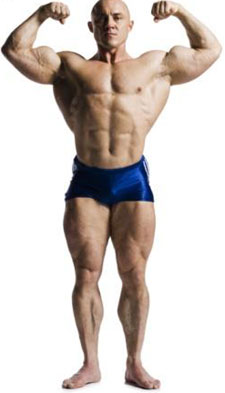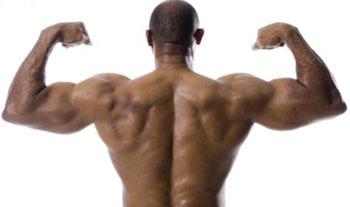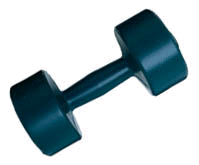|
The Sculptor in Training - How To Develop Your Physique to It's Fullest Potential By Working Different Parts of the Same Muscle
 One of the most common questions in weight training is "can you work different areas of the same muscle?" For example, can you work the lower biceps or the outer thighs? The quick answer is "yes", but as you'll soon see, reality is somewhat more complicated than that.
One of the most common questions in weight training is "can you work different areas of the same muscle?" For example, can you work the lower biceps or the outer thighs? The quick answer is "yes", but as you'll soon see, reality is somewhat more complicated than that.
Before we go into the how, we need to explore why it's useful to work different areas of a muscle. The main reason we want to work different areas of a muscle is in order to build a more balanced, aesthetically pleasing physique. If a person only focuses on a few exercises, they will tend to overdevelop certain areas of their muscles at the expense of others. This can make even a well-developed physique look incomplete or even downright bad.
Imagine a trainer who has spent all their time working only on the flat bench press. They will have well-developed chest muscles but the majority of that muscle will be in the middle to lower area of the chest, with very little in the upper area. This will give the visual impression of a droopy, bottom-heavy chest, which is not visually pleasing at all.
By selectively training specific areas of a muscle, you can create optical illusions. You can give the impression of wider shoulders by focusing on side deltoid (shoulder) training. You can give the impression of a higher, more well-developed chest with focused incline training. A tighter waist will make the shoulders appear wider while working the "peak" of the biceps will make that muscle appear higher and more dramatic. Emphasizing width in back training will help to create a nice V-taper that will give the illusion of wider shoulders and a smaller waist.
These optical illusions, put together and crafted through targeted training of specific aspects of your muscles, can help you to maximize your physique potential.
Now that you've learned why it's important to selectively train specific areas of the muscles, let's learn how to do it.
When a muscle is activated by the nervous system it contracts. The muscles operate under what is known as the "all-or-nothing" principle: either the whole thing contracts or it doesn't contract at all. This would lead us to believe that you can't focus on a specific area of the muscle. After all, if all the fibers have to contract when you lift a weight, you can't isolate a specific area of the muscle, right? Wrong.
The fibers in your muscles aren't all lined up in a perfectly straight line. If they were, it would be impossible to focus on specific areas of a muscle. But we live in a three-dimensional world and your muscles have to work in many different directions and at many different angles. This is what makes it possible to work different areas of the muscle.
When you lift a weight, even though the entire muscle contracts, depending on the angle at which the resistance is applied, some muscle fibers have more direct tension placed on them than others. The pectoral (chest) muscles are a great example of this. I don't think anyone will dispute that incline presses will put more tension on the upper pec muscle fibers than decline presses. The angle of the exercise places the majority of the tension on those upper fibers.

This is all well and good for a muscle such as the pectoralis. It's a fan-shaped muscle, making it easy to isolate different areas of the muscle by changing the angles. But what about different shaped muscles such as the biceps? The vast majority of the fibers of the biceps run in the same direction. Can specific areas of the biceps be isolated? Can you work the outer biceps or the inner biceps?
The answer to this question is a qualified "yes." Even though the majority of the fibers of the biceps run in a similar direction, you can place somewhat more tension on the inner or outer biceps, depending on how you apply the tension (for example, a wide-grip barbell curl versus a narrow-grip barbell curl). The only problem is, since most of the fibers do run in a similar direction, the difference in actual muscular development is going to be small. You're never going to have someone see you and say "Wow! Look at those inner biceps!"
The anatomy of the muscle itself will also determine the extent to which you can isolate specific areas. An excellent example of this is the deltoid (shoulder) muscle. The deltoid has three specific heads (a head is basically a separate section of the same muscle). These heads are the anterior (front), the lateral (side), and the posterior (rear) heads.
Even though all three heads of the deltoid end up at attaching to the same point on the upper arm bone (a.k.a. the humerus; this attachment point is anatomically known as an insertion), they originate on different areas of the shoulder. This gives each head of the muscle a different line of pull. If you raise your arm straight up to the front, you're working the front head, to the side, you're working the side head, to the rear, you're working the rear head. It's basically like attaching three ropes to the same hook on a wagon - you can pull the wagon with each rope but it will go in a different direction depending on which rope you pull.
Though this is a simple example, it can get a little more complicated when you start dealing with multi-headed muscles that have the same basic origin and insertion points. For example, if you have a look at the quadriceps muscle of the front thighs, it has four different heads. They all start and finish and in very similar places on the hips and knees.
 How do you isolate specific areas of a muscle like that? It's a bit trickier but it still can be done. It will depend largely on which exercises you do, how you do them, and how well you can mentally focus on the specific area of the muscle you are working. It may be something as simple as changing how your place your feet or even just trying to push (or pull) more in one direction than another.
How do you isolate specific areas of a muscle like that? It's a bit trickier but it still can be done. It will depend largely on which exercises you do, how you do them, and how well you can mentally focus on the specific area of the muscle you are working. It may be something as simple as changing how your place your feet or even just trying to push (or pull) more in one direction than another.
Mental focus is an often-overlooked but extremely important aspect of training, especially if you're trying to hit a certain area of a muscle. Often, by concentrating on contracting a specific area of a muscle more, you can actually recruit more muscle fibers from that area, helping to increase the work done by that area. This skill takes time and effort to develop but it will pay off. Not only will you be able to more selectively focus on the muscles you are contracting but you will be better able to feel how specific exercises work different areas of your muscles.
While a comprehensive list is beyond the scope of this article, here are a few examples of some exercises that you can use to focus on specific areas of your muscles:
Lower biceps: preacher curls
Biceps peak: cross-body hammer curls
Long head of the triceps: overhead dumbell extensions
Lateral head of the triceps: reverse grip pushdowns
Upper pecs: incline bench press
Lower pecs: decline bench press
Inner quads: leg extensions - lean over and hook your toes up
Outer quads: leg extensions - lean back and point your toes
Lower abs: lying leg raises
Upper abs: cross-bench crunches
Back width: wide grip pull-ups and pull-downs to the front
In conclusion, your ability to focus on specific areas of a muscle is going to depend on several factors. It will depend on the shape of the muscle, the specific anatomy of the muscle (origins and insertions), and how well you can mentally focus on that specific area. This ability to focus on specific areas your muscles will help you to create a more visually-pleasing physique by allowing you to act as a sculptor of your own body, selectively building muscle where it will have the most impact on your appearance.

More Articles by Author Nick Nilsson
Return To Weight Lifting Articles Archive
|